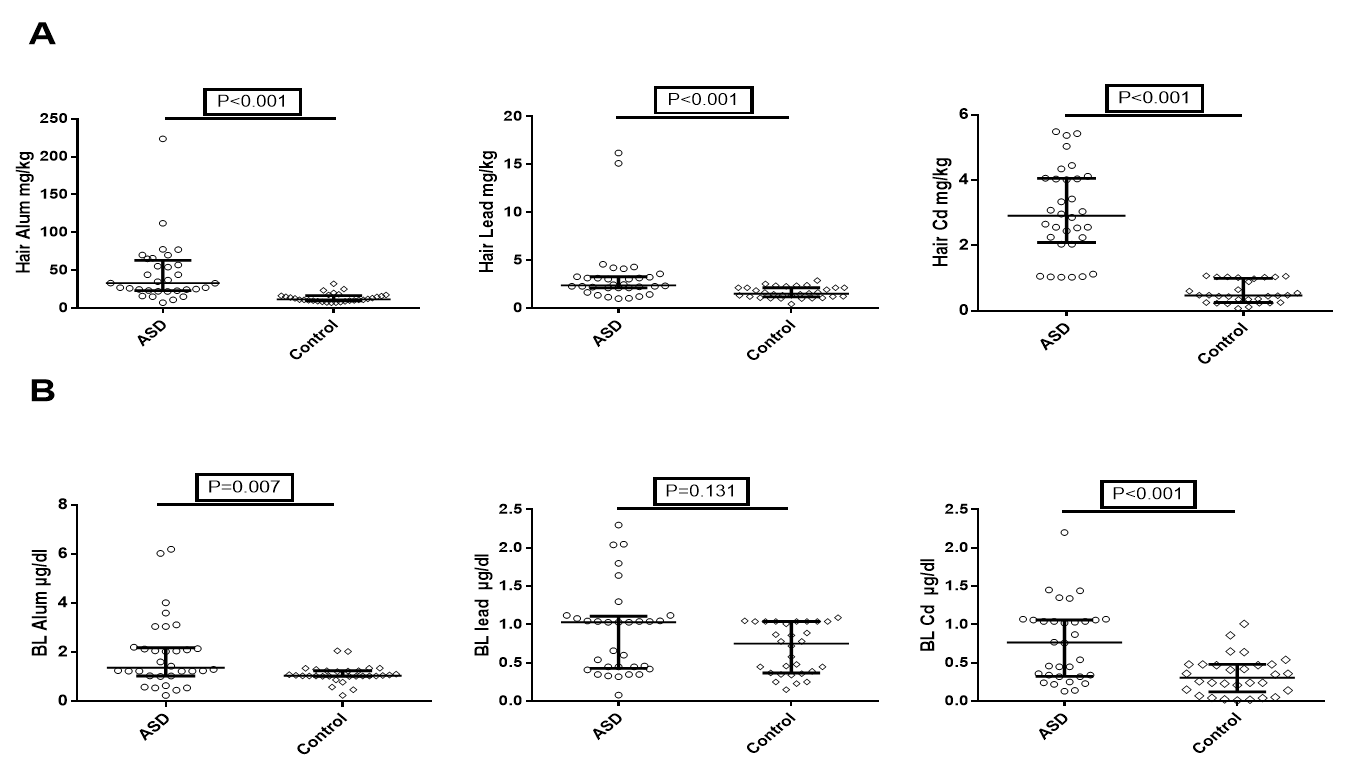1. Yousef AM, Roshdy EH, Abdel Fattah NR, Said RM, Atia MM, Hafez EM. Prevalence and risk factors of autism spectrum disorders in preschool children in Sharkia, Egypt: a community-based study. Middle East Curr Psychiatr. 2021;28(1):1-14. [
DOI:10.1186/s43045-021-00114-8]
2. Meguid NA, Nashaat NH, Elsaeid A, Peana M, Elnahry A, Bjørklund G. Awareness and risk factors of autism spectrum disorder in an Egyptian population. Res Autism Spectr Disord. 2021;84(101781):101781. [
DOI:10.1016/j.rasd.2021.101781]
3. Aljumaili OI, El-Dein A, Ewais E, El-Waseif AA, Abdul Jabbar Suleiman A. Determination of hair lead, iron, and cadmium in a sample of autistic Iraqi children: Environmental risk factors of heavy metals in autism. Mater Today. 2021. [
DOI:10.1016/j.matpr.2021.09.235]
4. Fiłon J, Ustymowicz-Farbiszewska JJ, Karczewski J, Żendzian-Piotrowska M. Analysis of trace element content in hair of autistic children. J Elem. 2017;22(4):1285-93. [
DOI:10.5601/jelem.2016.21.4.1355]
5. Mohamed Fel B, Zaky EA, El-Sayed AB, Elhossieny RM, Zahra SS, Salah Eldin W, et al. Assessment of Hair Aluminum, Lead, and Mercury in a Sample of Autistic Egyptian Children: Environmental Risk Factors of Heavy Metals in Autism. Behavioural neurology. 2015;2015:545674. [
DOI:10.1155/2015/545674] [
PMID] [
PMCID]
6. Al-Ayadhi LY. Heavy metals and trace elements in hair samples of autistic children in central Saudi Arabia. Neurosci (Riyadh). 2005;10(3):213-8.
7. Elsheshtawy E, Tobar S, Sherra K, Atallah S, Elkasaby R. Study of some biomarkers in hair of children with autism. Middle East Curr Psychiatr. 2011;18(2):6-10. [
DOI:10.1097/01.XME.0000392842.64112.64]
8. Svenaeus F. Diagnostic and statistical manual of mental disorders (DSM-5). Vol. 991. Washington, DC: American Psychiatric Publishing2013.
9. Ishak I, Rosli FD, Mohamed J, Mohd Ismail MF. Comparison of Digestion Methods for the Determination of Trace Elements and Heavy Metals in Human Hair and Nails. Malays J Med Sci. 2015;22(6):11-20.
10. Schopler E, Reichler RJ, DeVellis RF, Daly K. Toward objective classification of childhood autism: Childhood Autism Rating Scale (CARS). Journal of autism and developmental disorders. 1980;10(1):91-103.
https://doi.org/10.1007/BF02408436 [
DOI:10.1023/A:1026075306015] [
PMID]
11. Vaughan CA, Test review: E. schopler ME, van bourgondien GJ, wellman SR. Love childhood autism rating scale (2nd ed.). Los Angeles, CA: Western psychological services. J Psychoeduc Assess. 2011;29(5):489-93. [
DOI:10.1177/0734282911400873]
12. Dawkins T, Meyer AT, Van Bourgondien ME. The Relationship Between the Childhood Autism Rating Scale: Second Edition and Clinical Diagnosis Utilizing the DSM-IV-TR and the DSM-5. Journal of autism and developmental disorders. 2016;46(10):3361-8. [
DOI:10.1007/s10803-016-2860-z] [
PMID]
13. Bain SK, Allin JD. Book review: Stanford-Binet intelligence scales, fifth edition. J Psychoeduc Assess. 2005;23(1):87-95. [
DOI:10.1177/073428290502300108]
14. Gillberg C. Autism and autistic-like conditions," in Diseases of the Nervous System in Childhood. Aicardi J. London, UK: Mac Keith Press2009.
15. Dalton R, Forman MA, Boris NW. Pervasive developmental disorders and childhood psychosis. In: Behrman RE, Kleigman RM, Jensen HB, editors. Nelson Textbook of Paediatrics. 17th ed. Philadelphia: WB Saunders2003. 93-5 p.
16. Sehgal R, Gulati S, Gupta YK, Sapra S, Mehta M, Pandey RM. Blood heavy metal levels in children with Autism Spectrum Disorder: A cross- sectional study from northern India. J Nepal Paediatr Soc. 2019;39(1):6-14. [
DOI:10.3126/jnps.v39i1.19905]
17. McCrossin R. Finding the True Number of Females with Autistic Spectrum Disorder by Estimating the Biases in Initial Recognition and Clinical Diagnosis. Children. 2022;9:272. [
DOI:10.3390/children9020272] [
PMID] [
PMCID]
18. Yorbik O, Kurt I, Hasimi A, Ozturk O. Chromium, cadmium, and lead levels in urine of children with autism and typically developing controls. Biological trace element research. 2010;135(1-3):10-5. [
DOI:10.1007/s12011-009-8494-7] [
PMID]
19. Blaurock-Busch E, Amin OR, Dessoki HH, Rabah T. Toxic Metals and Essential Elements in Hair and Severity of Symptoms among Children with Autism. Maedica (Bucur). 2012;7(1):38-48. [
DOI:10.1016/S0924-9338(12)74444-9]
20. Seneff S, Davidson R, Liu J. Empirical data confirm autism symptoms related to aluminum and acetaminophen exposure. Entropy (Basel). 2012;14(11):2227-53. [
DOI:10.3390/e14112227]
21. Tian Y, Green PG, Stamova B, Hertz-Picciotto I, Pessah IN, Hansen R, et al. Correlations of gene expression with blood lead levels in children with autism compared to typically developing controls. Neurotoxicity research. 2011;19(1):1-13. [
DOI:10.1007/s12640-009-9126-x] [
PMID] [
PMCID]
22. Rahbar MH, Samms-Vaughan M, Dickerson AS, Loveland KA, Ardjomand-Hessabi M, Bressler J. Role of fruits, grains, and seafood consumption in blood cadmium concentrations of Jamaican children with and without Autism Spectrum Disorder. Res Autism Spectr Disord. 2014;8(9):1134-45. [
DOI:10.1016/j.rasd.2014.06.002] [
PMID] [
PMCID]
23. Bernard S, Enayati A, Redwood L, Roger H, Binstock T. Autism: a novel form of mercury poisoning. Medical hypotheses. 2001;56(4):462-71. [
DOI:10.1054/mehy.2000.1281] [
PMID]
24. Adams JB, Baral M, Geis E, Mitchell J, Ingram J, Hensley A. The severity of autism is associated with toxic metal body burden and red blood cell glutathione levels. J Toxicol. 2009:1-7. [
DOI:10.1155/2009/532640] [
PMID] [
PMCID]
25. Lanphear BP, Hornung R, Khoury J, Yolton K, Baghurst P, Bellinger DC, et al. Low-level environmental lead exposure and children's intellectual function: an international pooled analysis. Environmental health perspectives. 2005;113(7):894-9. [
DOI:10.1289/ehp.7688] [
PMID] [
PMCID]
26. Abu-Taweel GM, Ajarem JS, Ahmad M. Neurobehavioral toxic effects of perinatal oral exposure to aluminum on the developmental motor reflexes, learning, memory and brain neurotransmitters of mice offspring. Pharmacology, biochemistry, and behavior. 2012;101(1):49-56. [
DOI:10.1016/j.pbb.2011.11.003] [
PMID]
27. Blaylock RL, Strunecka A. Immune-glutamatergic dysfunction as a central mechanism of the autism spectrum disorders. Current medicinal chemistry. 2009;16(2):157-70. [
DOI:10.2174/092986709787002745] [
PMID]
28. Jarup L. Hazards of heavy metal contamination. British medical bulletin. 2003;68:167-82. [
DOI:10.1093/bmb/ldg032] [
PMID]









































